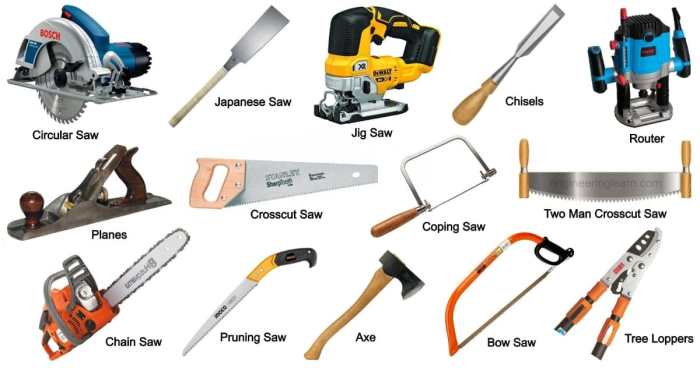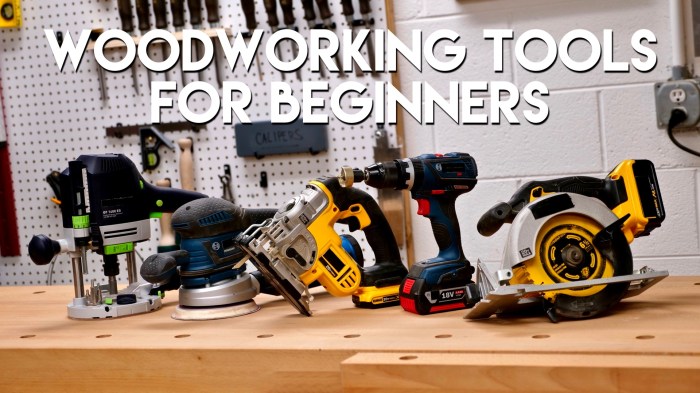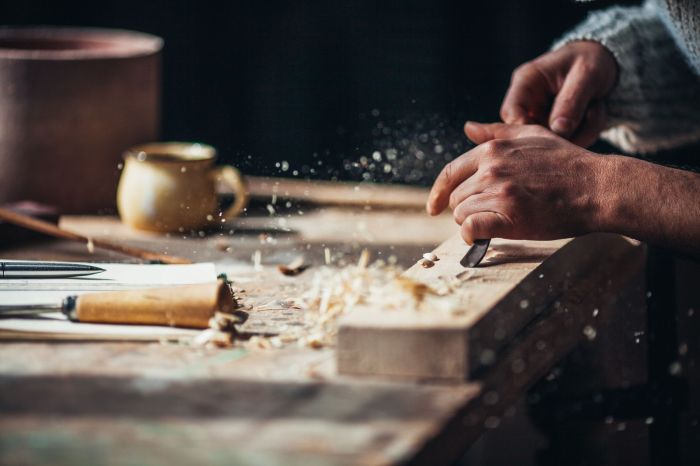Woodworking tools are the lifeblood of any woodworker, from seasoned professionals to enthusiastic beginners. These tools, ranging from simple hand tools to powerful machinery, have shaped our world for centuries, allowing us to transform wood into everything from intricate furniture to sturdy structures. Understanding the various types of woodworking tools, their proper use, and essential safety practices is crucial for anyone embarking on this rewarding craft.
This guide delves into the fascinating world of woodworking tools, exploring both the traditional and modern tools that empower woodworkers to create stunning works of art and functional pieces. We’ll cover essential hand tools like chisels, saws, and planes, as well as the powerful capabilities of power tools like routers, sanders, and table saws. We’ll also discuss the importance of choosing the right tools for your projects, maintaining them for optimal performance, and prioritizing safety in your woodworking endeavors.
Introduction to Woodworking Tools
Woodworking tools are essential for anyone who wants to create beautiful and functional wooden objects. They are used to shape, cut, join, and finish wood, allowing for a wide range of projects from simple furniture to intricate carvings. Understanding the different types of woodworking tools and their uses is crucial for successful woodworking.
History of Woodworking Tools
Woodworking tools have been used for thousands of years, evolving alongside human civilization. Early tools were simple, often made from stone, bone, or wood. As technology advanced, tools became more sophisticated, incorporating metals like bronze and iron. The development of powered tools, such as the electric saw and router, revolutionized woodworking in the 20th century, making it more efficient and accessible.
Types of Woodworking Tools
Woodworking tools can be categorized into several broad groups, each serving a specific purpose.
Hand Tools
Hand tools are essential for a variety of woodworking tasks, from basic cutting and shaping to intricate detail work. They are often preferred for their versatility, precision, and portability.
- Saws: Saws are used to cut wood, with different types designed for specific applications. Some common saws include:
- Handsaw: A general-purpose saw for cutting wood along the grain.
- Crosscut saw: Used for cutting wood across the grain.
- Backsaw: A fine-toothed saw used for precise cuts.
- Rip saw: A coarse-toothed saw for cutting wood along the grain.
- Jigsaw: A handheld saw used for cutting intricate shapes.
- Planes: Planes are used to smooth and shape wood by removing thin layers of material.
- Block plane: A small plane used for smoothing edges and end grain.
- Jack plane: A versatile plane used for general-purpose smoothing and shaping.
- Jointer plane: A long plane used for creating flat surfaces.
- Chisels and Gouges: Chisels and gouges are used for carving and shaping wood.
- Chisels: Used for cutting wood along the grain.
- Gouges: Used for carving curved shapes.
- Hammers and Mallets: Hammers and mallets are used for driving nails, chisels, and other tools.
- Claw hammer: A general-purpose hammer with a claw for pulling nails.
- Ball-peen hammer: Used for shaping metal.
- Mallets: Made from rubber or wood, used for striking chisels and gouges without damaging the wood.
- Screwdrivers: Screwdrivers are used for driving and removing screws.
- Phillips screwdriver: Used for driving Phillips-head screws.
- Flat-head screwdriver: Used for driving flat-head screws.
- Clamps: Clamps are used to hold pieces of wood together during assembly or gluing.
- Bar clamps: Used for holding large pieces of wood together.
- C-clamps: Used for holding smaller pieces of wood together.
- Spring clamps: Used for holding light-duty workpieces.
- Measuring Tools: Measuring tools are essential for accuracy in woodworking.
- Tape measure: Used for measuring length and distance.
- Ruler: Used for measuring smaller distances.
- Combination square: Used for measuring angles and distances.
Power Tools
Power tools offer increased speed, efficiency, and power compared to hand tools, making them valuable for a wide range of woodworking tasks.
- Circular Saw: A powerful saw used for cutting wood quickly and efficiently.
- Table Saw: A stationary saw used for making precise cuts, with a table to support the workpiece.
- Router: A tool used for shaping, trimming, and cutting grooves in wood.
- Planer: A tool used for smoothing and flattening wood surfaces.
- Jointer: A tool used for creating flat, straight edges on wood.
- Sanding Tools: Tools used for smoothing and finishing wood surfaces.
- Belt sander: A powerful sander used for removing large amounts of material.
- Orbital sander: A sander used for smoothing and finishing wood surfaces.
- Random orbit sander: A sander used for smoothing and finishing wood surfaces, leaving a swirl-free finish.
- Drill Press: A stationary drill used for drilling holes in wood with precision.
Finishing Tools
Finishing tools are used to protect and enhance the appearance of wood.
- Sandpaper: Used for smoothing and polishing wood surfaces.
- Stains: Used to color wood and enhance its grain pattern.
- Finishes: Used to protect wood from moisture, dirt, and scratches.
- Polyurethane: A durable finish that provides a clear, protective coating.
- Lacquer: A quick-drying finish that provides a hard, glossy surface.
- Oil-based finishes: Used for a natural look and feel.
Essential Hand Tools

Essential hand tools are the backbone of any woodworking project. They are versatile, portable, and often require less power compared to their power tool counterparts. These tools allow for precise control and are perfect for both beginners and experienced woodworkers.
Essential Hand Tool Overview
| Tool Name | Description | Uses | Safety Tips |
|---|---|---|---|
| Measuring Tape | A flexible tape measure with markings for accurate length measurements. | Measuring lumber, determining project dimensions, marking cut lines. | Avoid pulling the tape too forcefully to prevent damage. Keep the tape clean and dry. |
| Combination Square | A tool with a fixed blade and a movable head that allows for accurate measurements of angles and lengths. | Marking precise angles, checking squareness of cuts, measuring depth. | Handle the combination square carefully to prevent damage to the blade. Ensure the blade is securely attached to the head. |
| Carpenter’s Pencil | A pencil designed for marking wood with clear, visible lines. | Marking cut lines, transferring measurements, creating layout lines. | Sharpen the pencil regularly for clear lines. Use a pencil with a hard lead for durable marks. |
| Hand Saw | A saw with a toothed blade that is used for cutting wood by hand. | Cutting lumber to length, making crosscuts, ripping boards. | Always use a push stroke when sawing. Keep your fingers clear of the blade. Use a sawhorse or workbench for stability. |
| Chisel | A sharp-edged tool used for shaping and removing wood. | Chiseling mortises, carving details, cleaning up edges. | Use a mallet or hammer to strike the chisel. Always keep your fingers clear of the blade. Use a cutting board for stability. |
| Hammer | A tool with a head and handle used for driving nails and other fasteners. | Driving nails, striking chisels, assembling wood projects. | Use a hammer with a smooth, even head. Wear safety glasses when hammering. Avoid striking your hand with the hammer. |
| Screwdriver | A tool with a handle and a tip that fits into screw heads for driving and removing screws. | Driving and removing screws, assembling wood projects. | Use the correct screwdriver tip for the screw head. Apply even pressure when driving screws. Avoid stripping the screw head. |
| Clamp | A device used to hold pieces of wood together securely. | Securing wood pieces for gluing, holding workpieces in place during cutting. | Ensure the clamp is securely attached to the workpiece. Use a clamp with sufficient clamping force. Avoid overtightening the clamp. |
| Level | A tool with a bubble that indicates a horizontal or vertical plane. | Checking the level of surfaces, ensuring straight lines, aligning shelves. | Ensure the level is properly calibrated. Use a level on a stable surface. Avoid using a level in direct sunlight. |
| Sandpaper | A sheet of abrasive material used for smoothing and finishing wood surfaces. | Smoothing rough edges, removing imperfections, preparing wood for painting or staining. | Use the appropriate grit sandpaper for the desired finish. Sand with the grain of the wood. Avoid sanding too aggressively. |
| Wood Glue | A type of adhesive designed for bonding wood pieces together. | Joining wood pieces, creating strong and durable bonds. | Use the correct type of wood glue for the project. Apply glue evenly and clamp the pieces together. Allow the glue to dry completely. |
| Tool Name | Material | Maintenance Tips | Storage Recommendations |
|---|---|---|---|
| Measuring Tape | Steel, plastic | Clean the tape with a damp cloth. Avoid bending or twisting the tape. Replace the tape if it becomes damaged. | Store the tape in a dry place, rolled up in a protective case. |
| Combination Square | Steel, plastic | Clean the blade and head with a damp cloth. Lubricate the moving parts with oil. Store the combination square in a protective case. | Store the combination square in a dry place, with the blade protected. |
| Carpenter’s Pencil | Wood, graphite | Sharpen the pencil regularly. Store the pencil in a dry place. | Store the pencil in a pencil holder or a drawer. |
| Hand Saw | Steel, wood | Clean the blade with a damp cloth. Sharpen the blade regularly. Store the saw in a protective case. | Store the saw in a dry place, with the blade protected. |
| Chisel | Steel, wood | Clean the blade with a damp cloth. Sharpen the blade regularly. Store the chisel in a protective case. | Store the chisel in a dry place, with the blade protected. |
| Hammer | Steel, wood | Inspect the head for cracks or damage. Replace the head if necessary. Store the hammer in a dry place. | Store the hammer in a hammer holder or a drawer. |
| Screwdriver | Steel, plastic | Clean the tip and handle with a damp cloth. Replace the tip if it becomes damaged. Store the screwdriver in a tool box or drawer. | Store the screwdriver in a dry place, with the tip protected. |
| Clamp | Steel, plastic | Clean the clamp with a damp cloth. Lubricate the moving parts with oil. Store the clamp in a dry place. | Store the clamp in a tool box or drawer. |
| Level | Aluminum, plastic | Clean the level with a damp cloth. Avoid dropping or damaging the level. Store the level in a protective case. | Store the level in a dry place, with the bubble protected. |
| Sandpaper | Paper, abrasive material | Store the sandpaper in a dry place. Avoid folding or creasing the sandpaper. | Store the sandpaper in a drawer or a dedicated storage box. |
| Wood Glue | Polyvinyl acetate, epoxy resin | Store the glue in a cool, dry place. Keep the glue tightly sealed. | Store the glue in a cabinet or a dedicated storage area. |



